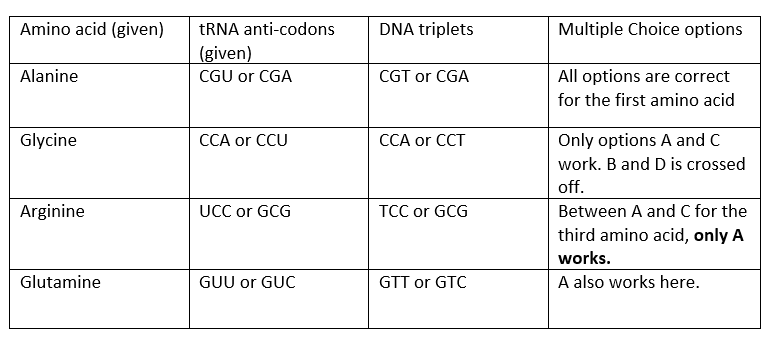Make a Difference – Donate to Bored of Studies!
Students helping students, join us in improving Bored of Studies by donating and supporting future students!
can someone help me with this question (1 Viewer)
- Thread starter emily_02
- Start date
mariakery1
New Member
- Joined
- Jun 29, 2018
- Messages
- 27
- Gender
- Female
- HSC
- 2019
Q19. The table provides information for the anti-codon of tRNA for each amino acid, and we need the DNA base triplet that codes for each amino acid.

Q20. Point D and B could be eliminated since blood leaving an active muscle is deoxygenated blood. When blood leaves an active muscle the pH decreases due to CO2 dissolved in the blood.

Q20. Point D and B could be eliminated since blood leaving an active muscle is deoxygenated blood. When blood leaves an active muscle the pH decreases due to CO2 dissolved in the blood.
thank you!!Q19. The table provides information for the anti-codon of tRNA for each amino acid, and we need the DNA base triplet that codes for each amino acid.

Q20. Point D and B could be eliminated since blood leaving an active muscle is deoxygenated blood. When blood leaves an active muscle the pH decreases due to CO2 dissolved in the blood.
ConquerHSC
Member
- Joined
- Sep 12, 2018
- Messages
- 57
- Gender
- Male
- HSC
- N/A
Just to add on, hemoglobin's binding affinity with oxygen decreases as the level of carbon dioxide increases (blood near active muscles). Hence, the saturation of haemoglobin by oxygen is lower (less oxyhaemoglobin and more carbaminohaemoglobin). Hence A is the answer and not B.
thank you for the added infoJust to add on, hemoglobin's binding affinity with oxygen decreases as the level of carbon dioxide increases (blood near active muscles). Hence, the saturation of haemoglobin by oxygen is lower (less oxyhaemoglobin and more carbaminohaemoglobin). Hence A is the answer and not B.



